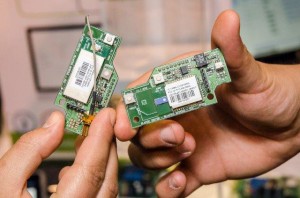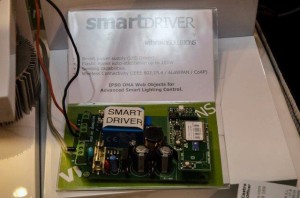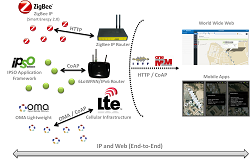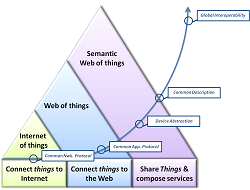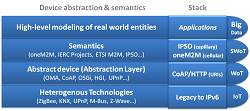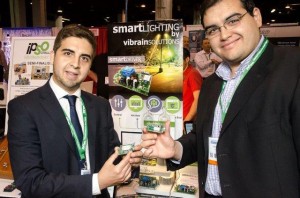 IPSO Application Framework for Smart Lighting Solutions
IPSO Application Framework for Smart Lighting Solutions
Contestants:Antonio J. Jara, Miguel Castro,
Gonzalo Pérez Foulquié, Antonio F. Skarmeta, David Fernandez Ros, Pablo Lopez Martinez, Miguel A. Zamora
Affiliations: viBrain Solutions S.L. and University of Murcia
Place: 3rd
Award: $2,500 USD
Summary
Smart Cities play an increasingly important role for the sustainable economic development of a determined area while are considered a key element for generating wealth, knowledge and diversity, both economically and socially.
viBrain Solutions is addressing the Smart Cities market with a Smart Lighting solution, since street lighting is one of the key enablers to reach the sustainability of its infrastructure, reduce the energy consumption and the levels of greenhouse gases (GHG).
The solution proposed by viBrain Solutions is composed of:
– A hardware component denominated Smart Driver with the functions of power supply (LED Driver) for a wide range of LED lampposts from 0-120W, sensing capabilities for humidity, light, temperature and noise, and finally with Wireless Connectivity through IEEE 802.15.4 / 6LoWPAN.
– A software component denominated viBrain Platform to monitor the street lights in order to be aware about the energy consumption, distribution, generation and environmental status. The viBrain Platform is enabled with a novel end-to-end IPv6/CoAP library based on HTML5 for ubiquitous access offering end-to-end connectivity without the needs of any software or pre-installed library in the clients to offer a suitable and scalable distribution of the client application.
IP connectivity presents a crucial role for this solution, since Smart Cities require efficient support for global communications and access to the services and information. In addition, this solution is enabled with the Advanced Smart Lighting Profile for street lights based on the IPSO Application Framework, since, homogeneous, interoperable and seamless communication is also required.
How does your Smart Object/Solution use Internet Technology?
Internet protocol is the main enabler of the product since IP connectivity presents a crucial role for Smart Lighting solutions. Smart Cities require offering efficient support for global communications and access to services and information. It is required to enable a homogeneous and seamless End-to-End/M2M communication in the different solutions and use cases.
In order to reach the End-to-End connectivity in a completely clean and direct way, it is supported, on the one hand, IPv6 through 6LoWPAN over IEEE 802.15.4 (2.4Ghz) and IEEE 802.15.4g (subGhz) in the Smart Driver (product allocated in the street light for sensing, communicating and power the LED arrays). On the other hand, it has been developed an HTML5/JavaScript library for embedded CoAP/IPv6 support through Web browsers, which was not feasible with the existing solutions since the incompatibility to build UDP sockets at the client side by Web Browsers.
Thanks to the two mentioned parts of the product, communications goes directly from client side (e.g., Web browser) to end nodes (e.g., sensor and LED lights connected to the Smart Driver). Thus, interoperability is achieved without the intervention of any kind of intermediate application server or gateway in charge of dealing with sending or requesting information neither from/to the client nor from/to the sensor, and this end-to-end capability is the result of relaying on the Internet Protocol as the main enabler of all our solution.
Finally, IP-based capabilities are opening a great number of opportunities for the integration with applications from external developers, and third party consumer devices.
Why did you choose to invent this? What problem does the inventor see that it can solve?
The main motivation to invent an Smart Driver for Smart Lighting was to consider that the most ubiquitous and existing infrastructure in the Cities are the Street Lights (Lamp Posts). Therefore, we considered that the street light could be the perfect infrastructure to offer the communications nerve for the city.
In addition, street lights present the 40% of the total energy spent in a city. Therefore, assuming that one of the initial IoT applications will be the smart energy and the efficient power consumption. It is considered crucial to address one of the current major power consumers in our ecosystem, in order to reduce the energy consumption and the levels of greenhouse gases (GHG).
Finally, we have solved the capability to control any kind of LED Light, since the invented Smart Driver offers a novel mechanism to adapt the power current to the required by the different street lights, in a range between (350-700mA) and (0-120W).
Therefore, the Smart Driver is on the one hand, a “Elastic” Driver to provide a flexible solution to power the different Street Lights available in the market, and on the other hand, this provides a platform to interconnect sensors (noise, humidity, temperature, motion, etc.) and connect. Thereby, more efficient and intelligent solutions can be delivered.
What is the practical application of your innovation for the everyday user?
The initial practical application is to offer an optimized power consumption of the street lighting in the Smart Cities. But this is also opening additional markets, since its potential to offer a nerve of data and communication sensed around the city.
For example, one of the coming products from viBrain solutions is focused on measure the noise levels in a city, in order to build noise maps and offer this information to state agencies that want to offer the quality of noise as an additional value, and also to the city halls to ensure that the pubs and clubs are not producing more noise that the regulated.
Did you invent new technology? How is your device unique?
Yes, we have invented the Smart Driver, which offers an elastic power supply for a range of different LED-based street lights. The current market requires a different driver with different features, e.g., 350mA and 70W, another with 700mA and 50W, etc..
This elastic capability of the Smart Driver makes it compatible with any street light from 350 to 700mA and 0 to 120W. Thereby, it avoids stock problems from the existing Street Lighting manufacturers, make easier the deployment since just one homogeneous driver needs to be commissioned, and finally since this offers a feedback mechanism to be aware of the status of the street light and its power consumption. This detects breakdowns and the most important this switch off the street light before breaks the LEDs when some overload or something goes wrong in the main power line.
What hurdles did you overcome in creating your device? Were necessary parts easily obtained?
Our solution is composed of a software and hardware components.
— HARDWARE —
Regarding the hardware component. The harder part has been to manage the power electronic part of the solution, since our background is telecommunications and computer science. But, thanks to the collaboration between the University of Murcia, they collaborated to satisfy the power electronic challenges reaching the “Elastic” features of the Smart Driver.
The Smart Driver integrates our experience in communication with 6LoWPAN. This part was the easier, since we had a good experience with Jennic/NXP. Thereby, we have been able to develop a solution based on IEEE 802.15.4 with the JN5139 chipset from Jennic/NXP.
— SOFTWARE —
Regarding the software components, the harder part was to build a Web-based library that allows end-to-end connectivity based on CoAP without any previous software installed in the client side. We considered as a major requirement for the success of our solution and IoT to make feasible that people could use our solution directly opening their browser.
The idea of offering a solution based on browser is feasible, always that you have a backend server to intermediate (proxy) between the devices and the client. But the higher challenge has been to offer the end-to-end connectivity directly between the browser from the client and the sensor using CoAP, when the current browsers do not know about CoAP.
This has been solved thanks to the potential of HTML5 (JavaScript) and Java Applets. Thereby, we have been able to offer a CoAP library embedded with the viBrain Platform (the M2M platform to manage the street lighting).
viBrain Platform is composed of a visual interface to configure, visualize and monitor the sensors, but this is also offering the end-to-end connectivity with the device in order to make it more scalable, reduce delays, and the most important exploit the potential of IP to offer end-to-end connectivity.
The easier part has been the development of the firmware for the Smart Driver with the support for the IPSO Application Profile, since our over 4 years experience with Contiki OS and the fantastic support for IP and CoAP offered by the Contiki OS community.
Are there plans to produce your entry for the marketplace, or is it already a product that can be purchased/obtained?
Yes, the start-up viBrain Solutions S. L. is registered in Spain with the VAT code: B73770166. viBrain Solutions is focused on exploit the IoT market through solutions powered by IP.
For that reason, viBrain Solutions has built the Smart Driver as an initial product to reach the market, in particular the Smart Cities market, since we consider the Smart City the initial enabler of the IoT face to the horizon 2020.
Why would you consider your device/solution to be “innovative”?
This solution is innovative because solve the current problems to manage high stocks of different drivers for the wide range of street lights. Remark that this elastic capability has been the most relevant feature initially for the current Street Lighting vendors and manufactures.
The Smart Driver offers novel capabilities such as a more accurate power monitoring and street lighting control with the remote communications.
Finally, viBrain Solutions is also offering the platform to integrate additional sensors and be the nerve for the communications coming from other sensors deployed in the city such as parking pots, traffic, and garden sensors, and the viBrain Plaftform with a novel CoAP integration in the client side to make feasible the end-to-end communication without the requirement of the previous set-up of a CoAP-related plugin or software.
What would you like to see in the future for the Internet of Things? Why should more companies utilize IP?
The most important for the future of the Internet of Things is reach a common Semantic Web of Things.
The first stage has been the Internet of Things with the potential of offering Internet connectivity (IP) to everything. After this initial stage, the Web of Things with RESTFul architecture and protocols such as CoAP make closer to the IoT to the users, since they are accessible through browsers and Web-technologies. The next step is the Semantic Web of Things, where all the IoT resources are interoperable. For that reason, we have considered IPSO Alliance as a key player to provide the semantic layer to the capillary networks from a more IP and open approach.
We think that the last movements in the cellular networks with the oneM2M (OMA, ETSI, 3GPP), needs to be followed up by the semantic and interoperability in the capillary side with solutions such as ZigBee-IP and the IPSO Application Profiles.
Finally, we think that after the Semantic Web of Things is reached, then the IoT will present all his potential with additional value to the solutions and deployments powered by the potential of the data. For that reason, this will make feasible the exploitation of all the data gathered with the Big Data technologies.
In definitive, the present of the IoT is the Web of Things, and the future will offer a Semantic Web of Things with the support and coordination of industrial alliances such as IPSO Alliance. Thereby, an exploitation of the IP-enabled connectivity and the gathered data will demonstrate the additional value that the IoT provides to the market.
You can see here 3 diagrams developed by viBrain Solutions about the vision of the market and stack.
1- “Vision-IoT ecosystem” presents the convergence between capillary (IPSO Alliance and ZigBee Alliance) and the cellular networks (oneM2M).
2- “Vision-Evolution-1″ presents the evolution from the IoT toward the Semantic Web of Things (enabled by the IPSO Application Framework and the works in the oneM2M).
3- “Vision-Evolution-2″ a more detailed stack about the future of the communications thanks to the presented evolution.
Website: http://www.

